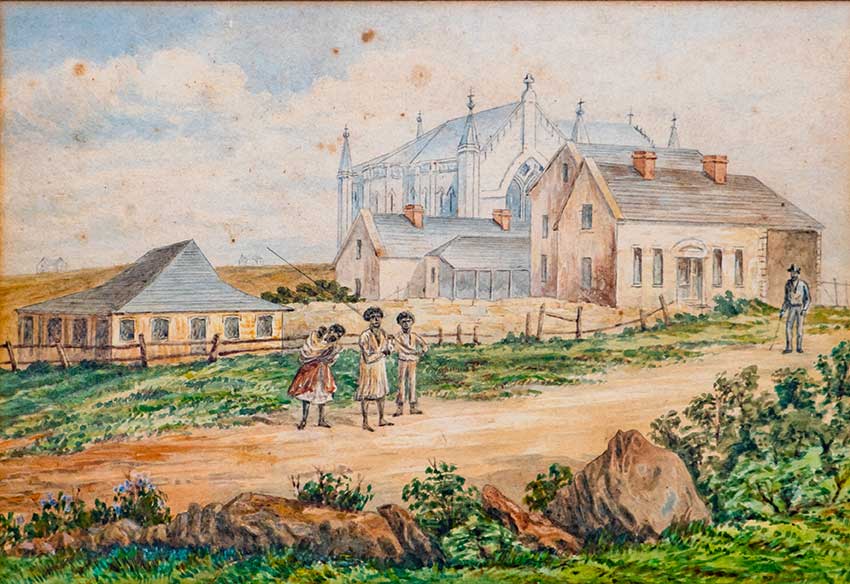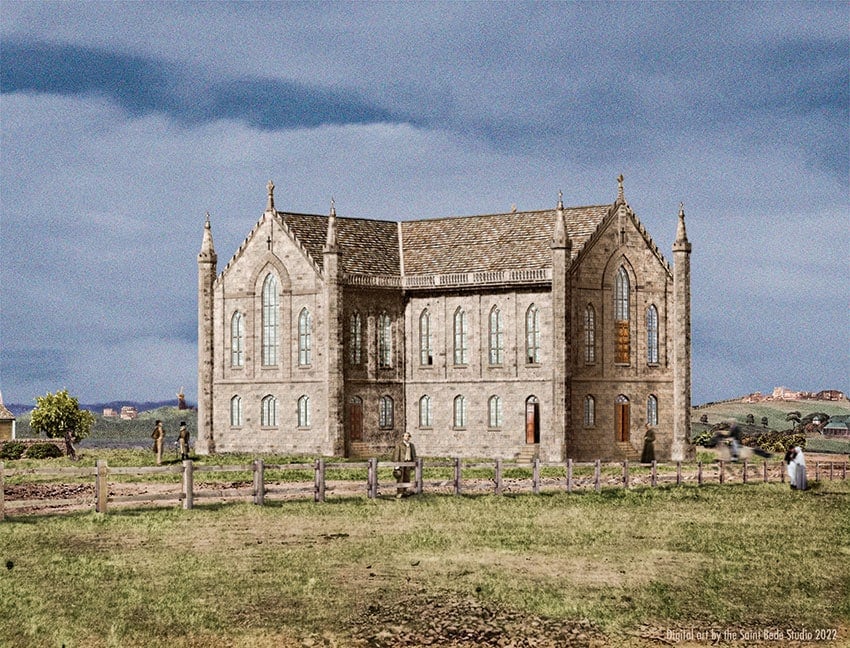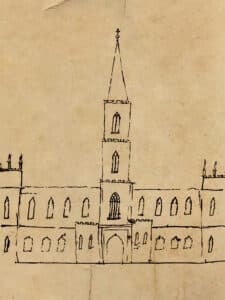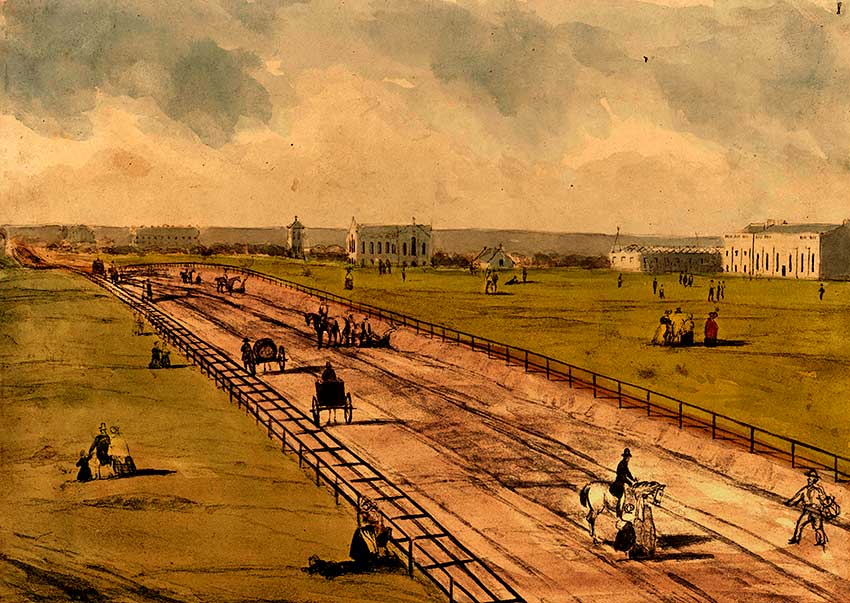
Fundraising completed, the project got underway. Perhaps not surprisingly, strong personalities and competing visions clashed. Yet cooler heads helped the project to overcome differences in outlook, the effects of drought and the economic problems it created. As a result a Catholic church stood on Australian soil.
Towards the end of 1821 (or perhaps in 1822), when fundraising for the Catholic chapel was proceeding well and the land for its construction allotted by a Crown Grant, the architect of the Colony of New South Wales, Francis Greenway, was asked to prepare a design for the chapel.
The Catholic Chapel Building Committee and Fr Therry had reached a decision that they did not want a timber building, expedient to immediate needs, but something more substantial.
This approach was supported by Fr Therry’s superior Monsignor Slater OSB, who lived on the island of Mauritius, and under whose jurisdiction the continent and islands of Australia then fell.
Francis Greenway was well-qualified to prepare a design for such a chapel; he had built several fine churches in the greater Sydney area (all of which still survive and continue to be used as churches 200 years later).
The plan Greenway drew-up for the Catholic Chapel has survived and shows a charming design in that style called Regency Gothic. It resembled the type of little church frequently found in rural areas of England.
It was intended to be a rectangular-shaped building – one large room – with beautifully detailed windows in stone and other ornaments carved in stone to enrich wall-surfaces, including provision for statues on the exterior wall at the altar-end of the building (the east).
“The initial work on Old Saint Mary’s began early in 1822 and involved a great deal of time and expense in levelling foundations and creating a basement area.”
But this design did not win the favour of Fr Therry. It has usually been suggested that the principal reason for the disagreement between these two determined men was that the chapel Greenway designed would be too small for anything other than the immediate needs of the mainly-convict Catholic population.
It is true that Fr Therry was more far-sighted. But he also had his own ideas about how that chapel should look and they did not correspond to Francis Greenway’s efforts.
At much the same time Fr Therry prepared his own design which he described as Rough Outlines for Intended Cathedral. His quirky effort, which looks like a cross between a multi-level wedding cake and an 18th Century English hall of residence, did not get off the drawing-board.
The initial work on Old Saint Mary’s began early in 1822 and involved a great deal of time and expense in levelling foundations and creating a basement area.
This was because the grant of land sloped down from the flat area of Hyde Park and was uneven throughout. It was not until the second half of 1823 that the walls themselves began to be laid above ground level.
As they began to take shape, it became obvious to Greenway that his design for the chapel was not being followed.

He wrote a couple of terse letters to Fr Therry, disassociating himself from the work and claiming that his designs had been “so much injured” as to make it impossible for him to offer further assistance.
It seems unlikely that Fr Therry ever intended to follow Francis Greenway’s drawings for the Chapel, but wished to pursue his own ‘Grand Design’. This was different in almost every detail and not particularly ecclesiastical.
As the walls continued to rise during 1824, passers-by observed that the building would be very large and was formed in the shape of a T.
There was to be a principal area for the congregation (called the nave) and abutting this at right angles, a transept on either side.
Initially, no one would have realised that the chapel was to have two rows of windows – a lower level and an upper level – all pointed at the apex in an attempt at the Gothic style.
“There were difficulties in obtaining labour – and skilled labour – to construct such a large chapel …”
By insisting on these, Fr Therry wished to ensure a maximum of cross-ventilation in the new chapel. The windows and doorways appeared all around the walls of the building.
The building of old Saint Mary’s took 11 years to reach a usable condition and was a struggle every step of the way.
There were difficulties in obtaining labour – and skilled labour – to construct such a large chapel; there were disputes at every level, but most especially there was a lack of money.
Greenway had warned at the beginning of the project how much money and skill it would take to construct a chapel on such a scale, but enthusiasm and optimism, rather than caution, prevailed.
Even as early as the end of 1822, expenditure had exceeded the generous donations that had been made, and this pattern continued.

Images: Archives of the Archdiocese of Sydney
During the 1820s, the various promises of Government subsidies were only in small part fulfilled. A drought in the second half of the 1820s brought on an economic depression in the Colony, which also impacted the building of the Chapel.
Nevertheless, at a time when construction was proceeding reasonably well in 1825-26, an unexpected turn of events became a major setback.
A newspaper misprinted a letter written by Fr Therry in such a way as to give significant offence to a member of the Colonial Establishment. Apologies were ignored and as a result of a printer’s error, Fr Therry was dismissed from his official position of Catholic Chaplain to the Colony.
The injustice of it caused a stir, but the Government was unmoved, because the newspaper misprint was their chance to rid themselves of a somewhat troublesome character.
At the end of 1826, another priest arrived to take up the position of Chaplain, Fr Daniel Power.
A “power-struggle” ensued between the two priests resident in Sydney, all of it unnecessary and unedifying.
With Saint Mary’s chapel half-built, Fr Therry and his supporters arranged to re-construct the schoolhouse and priest’s residence on the church land (which had been constructed between 1824 and 1826) so that a small chapel could be accommodated.
It was not a separate structure, but a wing of a larger E-shaped group of buildings. This was Saint Joseph’s Chapel. A number of drawings and paintings of the buildings on the site from the late 1820s onward show this chapel, schoolhouse and residence.
Although it has become common to describe old Saint Mary’s as Fr Therry’s church, there were several people whose contribution is not so well known, but without whom it could never have been built.
“It was Dempsey who massaged Fr Therry’s “Rough Outlines” for a “Cathedral” into a realistic building.”
Chief among these was a Catholic named James Dempsey. He had come to the Penal Colony of New South Wales from Ireland with many others (including three Catholic priests) who had been swept-up in the 1798 Rebellion in Ireland.
Dempsey was a member of the Catholic Chapel Building Committee. He was a man of some financial means, hard-working, a highly-skilled stone-mason and a devout Catholic.
It was Dempsey who massaged Fr Therry’s “Rough Outlines” for a “Cathedral” into a realistic building and it is James Dempsey who has the best claim to producing the chapel’s design.
For much of the 11 years of construction, Dempsey was also the foreman and master stone mason (although there were other stone masons too).
He arranged for labour and often paid for it out of his own pocket. He even went on an overseas fund-raising tour at a time when hardly anyone travelled overseas from Australia.

Image: Mitchell Library, State Library of NSW.
With a wonderful mixture of respect and Irish forthrightness, he kept Fr Therry and the project on course.
There were three other priests who contributed to the construction of the old church:
Fathers Daniel Power, John McEncroe and William Ullathorne. There were also influential Catholic laymen, who came to the Colony to carry out official duties for the Crown: Roger Therry and John Hubert Plunkett.
These two helped smooth the rocky road of Government cooperation with the project. They are only some of those who did but we cannot do much more than mention them so that their contributions continue to be remembered.
In 1830, after three years when almost nothing was done on the construction of the Chapel, the Colonial Government became more generous and assisted the project with the provision of labour, materials and subsidies.
Finally, the walls could be protected by the construction of a timber roof, but it was a further three full years before the chapel was in a state where it could be used – and barely so. It had finished solid stone walls, it had a timber floor, it had a massive roof of timber beams and shingles – but that was all.
“It was neither one thing, nor an another in terms of architectural style and it did not look much like a church, it must be admitted.”
The first Mass was offered within its walls on 5 December, 1833 and the privilege of celebrating that Mass was Fr Therry’s.
The above image gives a good indication of what old Saint Mary’s looked like and we can see that it was a rather plain-looking, squat edifice.
It was neither one thing, nor an another in terms of architectural style and it did not look much like a church, it must be admitted.
But because of its large size and completeness, it was much admired in Sydney and cherished by Catholics.
The great task of building a fitting place of worship had been achieved by the Catholics of the Colony.
To a new wave of Catholic leaders fell the task of fitting out the interior.
Related
